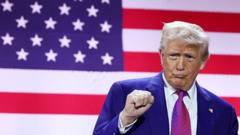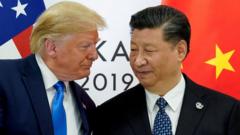Despite a new handshake agreement between the U.S. and China to ease trade tensions, experts suggest the deal merely returns both nations to a previous status quo from early April, highlighting the challenges of meaningful progress in their trade relationship.
New Trade Agreement: A Step Backward for U.S.-China Relations

New Trade Agreement: A Step Backward for U.S.-China Relations
Recent negotiations between the U.S. and China may only reset the economic tensions to pre-crisis levels, raising doubts about actual progress.
After intense negotiations this week, the United States and China have seemingly eased the threat of a major economic clash through a newly proposed handshake agreement. This accord, reached in the early hours of Wednesday in London, aims to reverse some of the detrimental economic measures that both sides imposed in recent months.
However, analysts are questioning the extent of any real gains made by President Trump's assertive trade strategies against China. Critics of the recent negotiations note that the deal essentially brings the two nations back to the state of affairs that existed before intense tensions flared in early April, when Trump began escalating tariffs on Chinese goods.
“It seems like we’re negotiating in circles,” remarked Myron Brilliant, senior counselor at DGA-Albright Stonebridge Group and former executive vice president of the U.S. Chamber of Commerce. He described the current process as one of escalation and de-escalation, highlighting that little progress has been achieved.
Under the tentative agreement, the existing tariffs will remain intact, with limited specifics being disclosed. It is anticipated that China will ease restrictions on mineral exports that posed a significant risk to many American manufacturers. Conversely, the United States may relax its limitations on technology and product exports, along with retracting previous visa threats aimed at Chinese students pursuing education in the U.S.
The lack of depth and firm commitment within this new agreement raises uncertainties about its durability and potential effectiveness, leaving observers to contemplate the broader implications for the ongoing U.S.-China economic relationship.






















